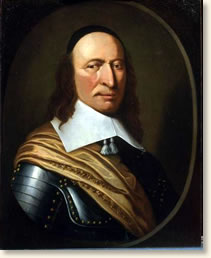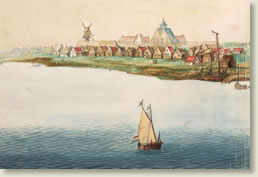|
A Portrait of New York City , 1679
 |
| Peter Stuyvesant |
It was a menacing Spector. As dawn broke on the morning of August 30, 1664, the inhabitants of the Dutch colony of New Amsterdam awoke to the sight of four English war ships anchored off the shore of their colonial outpost on the southern tip of the island of Manhattan. The English and the Dutch were at war on the European continent. The rising sun revealed to the residents of New Amsterdam that the conflict had reached their doorstep in the New World.
An envoy from the hostile armada soon arrived ashore with the demand that the island be surrendered immediately. After a few days of deliberation, Peter Stuyvesant, Governor of the outpost, wisely complied. Thus, the colonial outpost that the Dutch had established in 1613, to exploit the lucrative European market for furs (see Living Among the Mohawks, 1644), became an English possession.
The new landlords immediately changed the name of their latest acquisition from New Amsterdam to New York in honor their King, James II, who was also the Duke of York. The new English outpost prospered and enticed more adventurous settlers to its shores. However, New Yorkt did have competition from other American seaport cities such as Philadelphia and Baltimore. It was not until the completion of the Erie Canal in 1825 and the subsequent opening of the Western Frontier that New York City became a gateway to the West and America's dominant seaport (see Traveling the Erie Canal, 1836).
Two visitors to the outpost - Jaspar Danckaerts and Peter Sluyter - describe what they observed during their tour of the area. They are particularly impressed with how the European settlers quickly "go native" after establishing their residency:
"Sept. 24 – Oct 11, 1679
As it was Sunday, in order to avoid scandal and for other reasons, we did not wish to absent ourselves from church. We therefore went, and found there truly a wild worldly world. I say wild, not only because the people are wild, as they call it in Europe, but because most all the people who go there to live, or who are born there, partake somewhat of the nature of the country, that is, peculiar to the land where they live. We heard a minister preach, who had come from the up-river country, from Fort Orange [present-day Albany], where his residence is, an old man, named Domine Schaats, of Amsterdam. As it is not strange in these countries to have men as ministers who drink, we could imagine nothing else than that he had been drinking a little this morning. His text was, Come unto me all ye, etc., but he was so rough that even the roughest and most godless of our sailors were astonished.
The church being in the fort, we had an opportunity to look through the latter, as we had come too early for preaching. It is not large; it has four points or batteries; it has no moat outside, but is enclosed with a double row of palisades. It is built from the foundation with quarry stone. The parapet is of earth. It is well provided with cannon, for the most part of iron, though there were some small brass pieces, all bearing the mark or arms of the Netherlanders. The garrison is small. There is a well of fine water dug in the fort by the English, contrary to the opinion of the Dutch, who supposed the fort was built upon rock, and had therefore never attempted any such thing.... It has only one gate, and that is on the land side, opening upon a broad plain or street, called the Broadway or Beaverway.
27th. Wednesday. We started at two o'clock for Long Island. We went on, up the hill, along open roads and a little woods, through the first village, called Breukelen [Brooklyn], which has a small and ugly little church standing in the middle of the road. Having passed through here, we struck off to the right, in order to go to Gouanes. We went upon several plantations where Gerrit was acquainted with most all of the people, who made us very welcome, sharing with us bountifully whatever they had.
On [our] return home, we went from the city, following the Broadway. Upon both sides of this way were many habitations of negroes, mulattoes and whites. These negroes were formerly the proper slaves of the (West India) company, but, in consequence of the frequent changes and conquests of the country, they have obtained their freedom and set¬tled themselves down where they have thought proper, and thus on this road, where they have ground enough to live on with their families. We left the village, called the Bouweri [Bowery], lying on the right hand, and went through the woods to New Harlem, a tolerably large village situated on the south side of the island [now reckoned as the east side], directly opposite the place where the northeast creek and the East river come together, situated about three hours journey from New Amsterdam.
 |
| New York ca. 1664 |
11th [October], Wednesday. We embarked early this morning in his boat and rowed over to Staten Island, where we arrived about eight O'clock.... There are now about a hundred families on the island, of which the English constitute the least portion, and the Dutch and French divide between them about equally the greater portion. They have neither church nor minister, and live rather far from each other, and inconveniently to meet together. The English are less disposed to religion and inquire little after it, but in case there were a minister, would contribute to his support. The French and Dutch are very desirous and eager for one, for they spoke of it wherever we went.
When we arrived at Gouanes, we heard a great noise, shouting and singing in the huts of the Indians, who as we mentioned before, were living there. They were all lustily drunk, raving, striking, shouting, jumping, fight¬ing each other, and foaming at the mouth like raging wild beasts. Some who did not participate with them, had fled with their wives and children to Simon's house, where the drunken brutes followed, bawling in the house and before the door, which we finally closed. And this was caused by Christians [selling liquor]. Simon and his wife also do their best in the same way, although we spoke to them severely on the subject. They brought forward this excuse, that if they did not do it, others would, and then they would have the trouble and others the profit; but if they must have the trouble, they ought to have the profit, and so they all said, and for the most part falsely, for they all solicit the Indians as much as they can, and after begging their money from them, compel them to leave their blankets, leggings, and coverings of their bodies in pawn, yes, their guns and hatchets, the very instruments by which they obtain their subsistence. This subject is so painful and so abominable, that I will forbear saying anything more for the present."
References:
This eyewitness account appears in: Journal of a Voyage to New York in 1679-80, Long Island Historical Society, Memoirs (Brooklyn, 1867), reprinted in: Colbert, David EyeWitness to America (1997); Burrows, Edwin G., and Wallace, Mike, Gotham: A History of New York City to 1898 (1998).
How To Cite This Article:
"A Portrait of New York City, 1679" EyeWitness to History, www.eyewitnesstohistory.com (2011).
|






